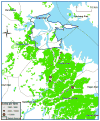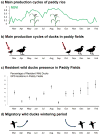Risks of avian influenza transmission in areas of intensive free-ranging duck production with wild waterfowl
- PMID: 24652313
- PMCID: PMC4047217
- DOI: 10.1007/s10393-014-0914-2
Risks of avian influenza transmission in areas of intensive free-ranging duck production with wild waterfowl
Abstract
For decades, southern China has been considered to be an important source for emerging influenza viruses since key hosts live together in high densities in areas with intensive agriculture. However, the underlying conditions of emergence and spread of avian influenza viruses (AIV) have not been studied in detail, particularly the complex spatiotemporal interplay of viral transmission between wild and domestic ducks, two major actors of AIV epidemiology. In this synthesis, we examine the risks of avian influenza spread in Poyang Lake, an area of intensive free-ranging duck production and large numbers of wild waterfowl. Our synthesis shows that farming of free-grazing domestic ducks is intensive in this area and synchronized with wild duck migration. The presence of juvenile domestic ducks in harvested paddy fields prior to the arrival and departure of migrant ducks in the same fields may amplify the risk of AIV circulation and facilitate the transmission between wild and domestic populations. We provide evidence associating wild ducks migration with the spread of H5N1 in the spring of 2008 from southern China to South Korea, Russia, and Japan, supported by documented wild duck movements and phylogenetic analyses of highly pathogenic avian influenza H5N1 sequences. We suggest that prevention measures based on a modification of agricultural practices may be implemented in these areas to reduce the intensity of AIV transmission between wild and domestic ducks. This would require involving all local stakeholders to discuss feasible and acceptable solutions.
Figures





Similar articles
-
Trade patterns facilitating highly pathogenic avian influenza virus dissemination in the free-grazing layer duck system in Vietnam.Transbound Emerg Dis. 2018 Apr;65(2):408-419. doi: 10.1111/tbed.12697. Epub 2017 Aug 16. Transbound Emerg Dis. 2018. PMID: 28815990
-
Migration of waterfowl in the East Asian flyway and spatial relationship to HPAI H5N1 outbreaks.Avian Dis. 2010 Mar;54(1 Suppl):466-76. doi: 10.1637/8914-043009-Reg.1. Avian Dis. 2010. PMID: 20521681 Free PMC article.
-
Epidemiology and phylodynamics of multiple clades of H5N1 circulating in domestic duck farms in different production systems in Bangladesh.Front Public Health. 2023 Jul 6;11:1168613. doi: 10.3389/fpubh.2023.1168613. eCollection 2023. Front Public Health. 2023. PMID: 37483933 Free PMC article.
-
Origin and evolution of highly pathogenic H5N1 avian influenza in Asia.Vet Rec. 2005 Aug 6;157(6):159-64. doi: 10.1136/vr.157.6.159. Vet Rec. 2005. PMID: 16085721 Review.
-
Vaccination of domestic ducks against H5N1 HPAI: a review.Virus Res. 2013 Dec 5;178(1):21-34. doi: 10.1016/j.virusres.2013.07.012. Epub 2013 Aug 3. Virus Res. 2013. PMID: 23916865 Review.
Cited by
-
Responses of migratory species and their pathogens to supplemental feeding.Philos Trans R Soc Lond B Biol Sci. 2018 May 5;373(1745):20170094. doi: 10.1098/rstb.2017.0094. Philos Trans R Soc Lond B Biol Sci. 2018. PMID: 29531149 Free PMC article. Review.
-
Prevalence and Distribution of Avian Influenza Viruses in Domestic Ducks at the Waterfowl-Chicken Interface in Wetlands.Pathogens. 2020 Nov 16;9(11):953. doi: 10.3390/pathogens9110953. Pathogens. 2020. PMID: 33207803 Free PMC article.
-
Construction of a recombinant duck enteritis virus (DEV) expressing hemagglutinin of H5N1 avian influenza virus based on an infectious clone of DEV vaccine strain and evaluation of its efficacy in ducks and chickens.Virol J. 2015 Aug 13;12:126. doi: 10.1186/s12985-015-0354-9. Virol J. 2015. PMID: 26263920 Free PMC article.
-
A brief history of bird flu.Philos Trans R Soc Lond B Biol Sci. 2019 Jun 24;374(1775):20180257. doi: 10.1098/rstb.2018.0257. Philos Trans R Soc Lond B Biol Sci. 2019. PMID: 31056053 Free PMC article. Review.
-
Highly Pathogenic Avian Influenza Viruses at the Wild-Domestic Bird Interface in Europe: Future Directions for Research and Surveillance.Viruses. 2021 Jan 30;13(2):212. doi: 10.3390/v13020212. Viruses. 2021. PMID: 33573231 Free PMC article. Review.
References
-
- Alexander DJ. An overview of the epidemiology of avian influenza. Vaccine. 2007;25:5637–5644. - PubMed
Publication types
MeSH terms
Grants and funding
LinkOut - more resources
Full Text Sources
Other Literature Sources
Medical

